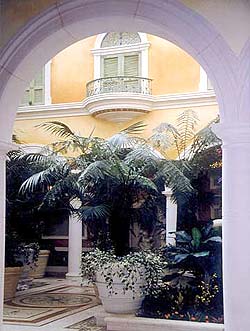
Barth White, Las Vegas, Nevada
Barth White has been a part of faux finishing since its advent as the decorative mainstay of the wealthy through its explosion into mainstream popularity.
By Christianna McCausland
Faux Effects can be likened to the decorative finishes it creates: a careful blend of artistic talent and business savvy coming together to create a beautiful product. President Barth White, 46, has been a part of faux finishing since its advent as the decorative mainstay of the wealthy through its explosion into mainstream popularity. His Las Vegas-based company has reaped the benefits of his keen eye for market trends.
Barth has built his business on the strength of his contracts with casinos. But as a young person growing up in Las Vegas, he had more experience working in casinos than on them. Upon completing college in 1979, Barth embarked on a career as a wallpaper contractor. When he returned to Las Vegas with only a few weeks of wallcovering experience under his belt, his first job was to hang wallpaper at the secret hideaway of Howard Hughes where the walls had been punched out searching for Hughes' will. Through that job, Barth learned valuable lessons about experience and learning by doing. 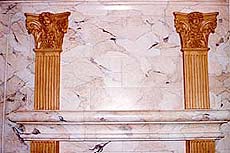 "I tried it for a few days and realized I wasn't getting anywhere, so I hired a couple of experienced union guys and they did in an hour what took me two days," he recalls. "So I became an apprentice to my employees and learned from them. That's how I learned the wall patching and wall covering business." Barth explains that it was the same with painting. What he did not know himself, he hired an experienced painter to teach him on the job. "I was always good at sales so I could land the jobs, but until I got really good at what I did, I worked with some really talented guys." "I tried it for a few days and realized I wasn't getting anywhere, so I hired a couple of experienced union guys and they did in an hour what took me two days," he recalls. "So I became an apprentice to my employees and learned from them. That's how I learned the wall patching and wall covering business." Barth explains that it was the same with painting. What he did not know himself, he hired an experienced painter to teach him on the job. "I was always good at sales so I could land the jobs, but until I got really good at what I did, I worked with some really talented guys." After a brief stint in metal studs and drywall, Barth returned to painting and wall covering. His high-end residential projects introduced him to faux finishing. He recalls that he was "charging up to $80,000 to paint a custom home; I can remember a couple of times artists would come in and charge as much as $30,000. They were in and out in two weeks while we were there with a full crew for two or three months. That was the stage when I realized I needed to learn how to faux paint."
At that time, there were only a few schools of decorative painting. Joanne Day, Liz O'Neill and Ina Marx were expensive, so he enrolled in the University of California at Santa Barbara, a decision that proved fortuitous for a man who wanted to set his work apart from the decorative painting crowd. Instead of preaching tools and techniques, instructors at UCSB encouraged students to be creative, to wander into a garage and look for anything that could create a finish.
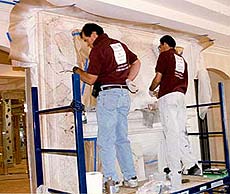 Barth took to faux finishing quickly, perhaps because it tapped into an artistic talent that was nurtured in high school when a broken back excluded him from physical education classes and he took extra art courses instead. He did not emerge as an artistic talent again until he began faux finishing. Barth took to faux finishing quickly, perhaps because it tapped into an artistic talent that was nurtured in high school when a broken back excluded him from physical education classes and he took extra art courses instead. He did not emerge as an artistic talent again until he began faux finishing.
"I started finding all these odd shaped chisels and I started doing more sculpted finishes with drywall mud and oil bases and glazing with beer batter glazes," Barth recalls. "I would be in my garage until two or three in the morning creating with materials to see what they'd do."
Barth's creativity paid off. His samples became recognized for something that was beyond the ordinary scope of the industry standard for marbling and glazes.
 In Las Vegas no two paint jobs are ever alike, but the finished job is normally spectacular. In Las Vegas no two paint jobs are ever alike, but the finished job is normally spectacular. |
As a result of his high-end residential work, Barth received his first casino contract at Caesar's Palace. After Caesar's Palace came the Rio Hotel and Casino, and from there the sky was the limit! His portfolio includes the homes of A-list celebrities, hotel/casino properties from coast to coast and projects that reach around the world. He created the meticulously gilded frame inserts that showcase invaluable paintings by Seurat and Manet, a job he admits was such an honor, he would have completed it for free. Barth has achieved such success in his field, he was forced to eliminate wallpapering from his company's offerings in 1994 and is now devoted exclusively to decorative painting. He obtains most new work through referrals. Barth's success carried over into love as well. Interior designer Deborah Sczudlo became his wife, soul mate and a perfect sounding board for his creative ideas on color and form.
In 1995, Barth brought his experience in decorative painting to the masses when he founded Barth's Faux Effects Decorative Finishes Studio. There students learn the fundamentals of designer wall finishes, furniture finishes, Trompe L'Oeil, and stone and marble using techniques that can be interesting and creative without being as labor intensive. "Because we are contractors, we realize people need to make money at what they do," says Barth. "We are teaching techniques. A really good faux artisan has an arsenal of techniques that compliments the use of colors." In addition to the more than eighty students his school reaches in a year, Barth has trained more than 300 union employees.
The greatest challenge facing the faux painting industry today — and what Barth hopes to combat in his classroom — is a lack of technical knowledge. Clients may bring him a sample finish from across the globe to be duplicated. Barth's artistic ability allows him to look at a finish and understand its integrity: Is it several layers and undertones that can be recreated? Or would it be better suited to a wall glaze mottled with another color to create a smooth graduation of color? Knowing color, translucency and correct applications is the key. "When we teach here, we ask our students to look at books on the old villas of Italy and Europe to get an understanding of what they are doing first," says Barth. "If you don't know what a fresco is and someone asks you to create one, you'll keep going in the wrong direction." Barth also advises would-be faux painters to learn their products. When Barth first started, there were only a handful of decorative painting products. Today's market has seen an explosion of new products that requires tremendous product knowledge.
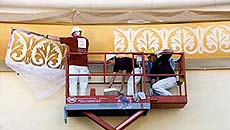 Through experience, Barth has found that to produce a consistent final product, it is advisable to break the process into separate steps. "If I teach four people the whole finish, I'm going to have four different end results," says Barth. "So we teach a few students one step and another team the second step so all they're doing is one part of the finish. For some of the veining and extremely detailed work, we bring in some of the more talented artists. That helps to sustain a high level of quality control." Through experience, Barth has found that to produce a consistent final product, it is advisable to break the process into separate steps. "If I teach four people the whole finish, I'm going to have four different end results," says Barth. "So we teach a few students one step and another team the second step so all they're doing is one part of the finish. For some of the veining and extremely detailed work, we bring in some of the more talented artists. That helps to sustain a high level of quality control."
The artistic creativity that accompanies the faux finish painter is what sets him apart from a straight painter. Unlike a straight painter who is a necessity, the decorative painter is a sought after accessory. And in today's market place, Barth believes that every painter should know some faux finishing techniques, even if it is just a simple glaze. For the straight painter, making the transition can be easy. "Straight painting knowledge is definitely an asset to faux finishing because you have to do everything you do in straight painting and more," says Barth. "You have to learn how to prime the walls and mask and spray, so once you have those fundamentals down, the faux painting is much easier."
He also reminds his colleagues that your results are your reputation: "You have to offer a good service and you have to listen," Barth recommends. "Word of mouth sells. If you have happy clients, you have work."
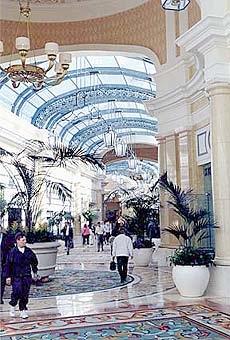 Verdigris -- 42 miles of metal for the glass atrium was faux finished throughout the hotel. Verdigris -- 42 miles of metal for the glass atrium was faux finished throughout the hotel. |
Barth has been in the business since 1980 and has seen just about every problem or unusual situation that can arise on a project. Getting equipment and products into hotels and casinos can be a real challenge. Some of Barth's fondest memories are of finding creative solutions to accessibility problems. He once used a helicopter to fly in a scissor lift for a project. Another time, he used hundred-foot cranes to move Bozeman cages. He has looked on as his team, working in those Bozeman cages, dangled in the slightest breeze. His largest project, the Bellagio in Las Vegas, entailed the faux finishing of more than 42 miles of metal with a verdigris finish that took two years to complete. It was not unusual to find Barth's workers manning several cherry pickers and scissor lifts in the pursuit of completing stencil work.
Barth devotes more time now to client relations, but he still keeps his hand in the creative process and understands the importance of personalized service. "I design and create the finishes that the foreman then learns and passes on to the employees," he explains. "My job is still creating finishes and samples and being hands-on with the clients. We work for celebrities, casino owners and other high-profile clients, and I make sure that I am an integral part of the process." It is not tough to understand why; Barth had a client fly him to a ski resort in a private Leer jet simply to paint a switch plate.
The amount of knowledge required of today's painter is vast, but Barth is quick to point out that in addition to the artistic side, business sense and a thirst for knowledge are definite prerequisites to success. "Any time you don't think you need to learn something, you're making a mistake," he says. "There are new products and new paints and you need to get out there and test them yourself so you know which ones are the best and how to use them. If you put your heart into the business and understand all its aspects, there is success to be had. There is nothing more rewarding then a client who puts their complete trust in you."

|

